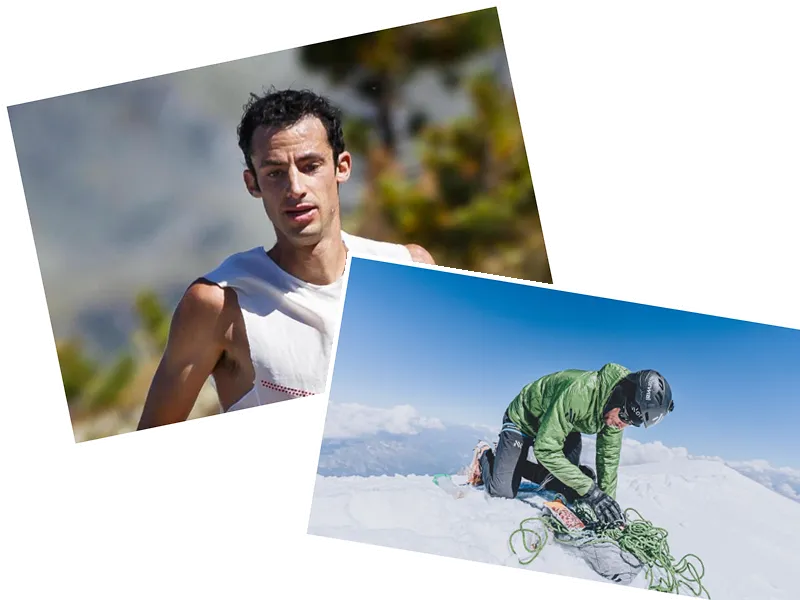Nineteen days: that's how long it took Catalan skyrunner Kilian Jornet Burgada to connect the 82 peaks of the Alps above four thousand meters, moving on foot or by bike. AlpineConnections is the name of the latest project by the thirty-six-year-old champion who, after having connected the 177 peaks of the Pyrenees above three thousand meters last year, has set his sights on the Alps for his new feat.
Starting last August 13 from Sankt Moritz (Switzerland), Jornet Burgada moved from East to West, from Piz Bernina to the Écrins massif, via Monte Rosa, Matterhorn and Mont Blanc, a route 1,207 kilometers long with 75,344 meters of positive altitude difference. There were sixteen stages in total on this journey, already completed by others previously, such as the Swiss Ueli Steck, who took 62 days in 2015. But no one has ever managed to keep up with Kilian Jornet Burgada. Sleeping an average of just over five hours a night, he accomplished one feat after another, managing to climb 18 peaks in a single day, thus completing the 'Spaghetti Tour', an itinerary that a mountaineer usually completes in several days.
During the test, the Spaniard allowed himself just one day to recharge his batteries once he reached Val Ferret, before attacking the Mont Blanc massif, which he completed in just two days, walking for 17 consecutive hours on the first day and for over 20 hours on the second. Afterwards, the Gran Paradiso, peak number 80, before moving by bike to Val d'Isère (France) and from there completing the Alpine Connections project by climbing the Barre des Ecrins and the Dôme des Neiges des Ecrins, in the Dauphiné Alps.
It is a monumental feat. Unimaginable. In just 19 days, Kilian Jornet has ticked off, using only his legs, the 82 peaks over 4,000 m in the Alps, when the previous record set in 2008 by the Italians Franco Nicolini and Diego Giovannini was 60 days. Two Swiss, Peter von Känel and Christian Maurer, had already lowered it to 51 days at the beginning of the summer, but using paragliders.
The Catalan's crazy odyssey has just ended in the Hautes-Alpes with the ascents of the Dôme de Neige (4,015 m) and the Barre des Écrins (4,102 m) on Saturday evening. A page in the history of mountaineering has just been written and we don't know if it will ever be turned, as this record now seems unattainable.
1,207 km in 267 hours. Far from the Babylonian frenzy that was raging in Chamonix at the same time for the UTMB — the race that revealed him in 2008 — Kilian Jornet cut his time without fanfare, in the silence of the night that enveloped the Pré de Madame Carle, at the foot of the 4,000 most westerly peaks of the Alps. The figures on his GPS watch are crazy: 1,207 km (including part of it by bike for the connections between the valleys) covered in 267 hours, 75,000 m of positive elevation gain, and an average of 5 hours and 17 minutes of sleep per night.
For comparison, Tadej Pogacar rode 'only' 83 hours on his victorious Tour last July. The parallel ends there, because the risks taken by Jornet in the high mountains are incomparable. Up there, you have to avoid the trap of crevasses on glaciers, unstable stones on technical ridges that do not allow any misstep. The brain is not allowed the slightest relaxation while hypoxia above 4,000 m crushes the meninges.
The slightest mistake is fatal. It is difficult not to think of Patrick Berhault, the star of French mountaineering in the 1990s, who died in 2004 while attempting the same sequence.
'I think it's one of the hardest things I've ever done, both physically, technically, as well as mentally,' says Kilian Jornet. Alpine connections 'I think it’s one of the hardest things I’ve ever done, both physically, technically, and mentally,' admitted Kilian Jornet in front of a pile of pizzas ready to be devoured, lit only by the headlamps of his loved ones waiting for him at the foot of the Blanc Glacier. 'Having to stay in a state of total concentration for 19 days requires a lot of energy, but it was incredible. I will especially remember the moments shared with my friends on the ridges, all the sunrises and sunsets on the highest mountains in the Alps. Now I have to rest to assimilate all of this.'
For the uninitiated, it is difficult to really imagine what the 'ultra-terrestrial' has just done. The difficulties are obviously not understood as in trail running. The mountains that the Spanish Pac-Man has devoured at an incredible speed, often completely solo, are much less known and frequented than a GR like the Tour du Mont Blanc, for example, the crowd of hikers having nothing to do with the niche that the practice of mountaineering represents.
'There is no equivalent in the world.' 'He pushed the limits of fast mountaineering to a level that we never thought we could reach,' says Benjamin Védrines, a current leader in the discipline, who accompanied the Catalan on the 4,000 in the Hautes-Alpes, where he lives. 'Even for me, a sequence at that speed seems difficult to imagine. The work he has done in training for years is unmatched, there is no equivalent in the world. It is simply inspiring.'
Jornet's 82,4000 meters in 19 days are like a culmination of his vision of the mountain, as he has practiced it for nearly twenty years by breaking the codes, as he did in trail running where he won everything. Fast, light, using sneakers rather than big mountaineering boots... Kilian Jornet has created a new discipline tailored to him, that of ultra-mountaineering.






